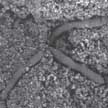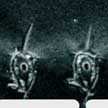Showing Spotlights 609 - 616 of 629 in category All (newest first):
 Applying atomic layer deposition (ALD) to biological macromolecules opens a route to fabricate metal oxide nanotubes and thin films with embedded biomolecules. The combination of biomaterials and ALD does not yet allow for a construction of a device. However, there are some indications that the synthesis of thin films with embedded functional biomolecules, such as ferritin, might be suitable for e.g. flexible electronics.
Applying atomic layer deposition (ALD) to biological macromolecules opens a route to fabricate metal oxide nanotubes and thin films with embedded biomolecules. The combination of biomaterials and ALD does not yet allow for a construction of a device. However, there are some indications that the synthesis of thin films with embedded functional biomolecules, such as ferritin, might be suitable for e.g. flexible electronics.
Jun 29th, 2006
 The scientific interest in magnetic nanostructures, both from a fundamental viewpoint and also due to their potential in a wide range of applications, over the past few years has led researchers to develop various nanofabrication methods for synthesizing nanomagnets. Applications for nanomagnetic materials include non-volatile magnetic random access memory (MRAM), highly sensitive magnetic field sensor, field programmable spin logic, and patterned media for ultra high density data storage.
The scientific interest in magnetic nanostructures, both from a fundamental viewpoint and also due to their potential in a wide range of applications, over the past few years has led researchers to develop various nanofabrication methods for synthesizing nanomagnets. Applications for nanomagnetic materials include non-volatile magnetic random access memory (MRAM), highly sensitive magnetic field sensor, field programmable spin logic, and patterned media for ultra high density data storage.
Jun 20th, 2006
 A newly developed electrostatic force directed assembly (ESFDA) technique is used to efficiently coat carbon nanotubes (CNTs) with nanoparticles. This new method advances the current technology by enabling rapid and in-situ coating of CNTs, multicomponent hybrid nanostructures, more control over the assembly process, and the possibility of tuning properties of the resulted hybrid structures.
A newly developed electrostatic force directed assembly (ESFDA) technique is used to efficiently coat carbon nanotubes (CNTs) with nanoparticles. This new method advances the current technology by enabling rapid and in-situ coating of CNTs, multicomponent hybrid nanostructures, more control over the assembly process, and the possibility of tuning properties of the resulted hybrid structures.
Jun 7th, 2006
 NanoFermentation is the first system to use industrial bioprocessing methods to manufacture nanometer-scale inorganic engineering materials rather than organic compounds. NanoFermentation harnesses the natural metabolic processes of metal-reducing bacteria to create tailored, single-crystal nanoparticles of important engineering materials, particularly ferrites.
NanoFermentation is the first system to use industrial bioprocessing methods to manufacture nanometer-scale inorganic engineering materials rather than organic compounds. NanoFermentation harnesses the natural metabolic processes of metal-reducing bacteria to create tailored, single-crystal nanoparticles of important engineering materials, particularly ferrites.
Jun 5th, 2006
 Nanosprings, which are helical nanowires grown via a modified vapor-liquid-solid (VLS) mechanism, are of interest to researchers because of their potential applications in biological and chemical sensors, high porosity applications such as fuel cells, and biomedical drug delivery applications. Thanks to a novel fabrication method, nanosprings can now be synthesized with a yield higher than 90%, and with 100% repeatability.
Nanosprings, which are helical nanowires grown via a modified vapor-liquid-solid (VLS) mechanism, are of interest to researchers because of their potential applications in biological and chemical sensors, high porosity applications such as fuel cells, and biomedical drug delivery applications. Thanks to a novel fabrication method, nanosprings can now be synthesized with a yield higher than 90%, and with 100% repeatability.
May 25th, 2006
 New research shows that soft, conformable sub-wavelength phase masks can be used, with 2-photon effects, to pattern in a parallel fashion and in a single exposure step large, 3D structures in certain classes of photopolymers. The result is a technique that is simple from an experimental standpoint, but which fully exploits the flexibility and patterning capabilities enabled by 2-photon effects, making it useful for applications in photonics, microfluidics and biotechnology.
New research shows that soft, conformable sub-wavelength phase masks can be used, with 2-photon effects, to pattern in a parallel fashion and in a single exposure step large, 3D structures in certain classes of photopolymers. The result is a technique that is simple from an experimental standpoint, but which fully exploits the flexibility and patterning capabilities enabled by 2-photon effects, making it useful for applications in photonics, microfluidics and biotechnology.
May 22nd, 2006
 Tightly focused femtosecond laser pulses have been used to modify transparent dielectric materials, to form voids, and to polymerize resists and resins for more than a decade. A high sub-100-nm spatial resolution has now been reached making it potentially a nano-fabrication tool.
Tightly focused femtosecond laser pulses have been used to modify transparent dielectric materials, to form voids, and to polymerize resists and resins for more than a decade. A high sub-100-nm spatial resolution has now been reached making it potentially a nano-fabrication tool.
May 11th, 2006
 Researchers at the University of New Mexico have demonstrated a new, simple, and facile approach to the fabrication of various nanopatterned films composed of nanoparticles. The findings could lead to nanoparticle sensors for both biological and chemical species.
Researchers at the University of New Mexico have demonstrated a new, simple, and facile approach to the fabrication of various nanopatterned films composed of nanoparticles. The findings could lead to nanoparticle sensors for both biological and chemical species.
May 10th, 2006
 Applying atomic layer deposition (ALD) to biological macromolecules opens a route to fabricate metal oxide nanotubes and thin films with embedded biomolecules. The combination of biomaterials and ALD does not yet allow for a construction of a device. However, there are some indications that the synthesis of thin films with embedded functional biomolecules, such as ferritin, might be suitable for e.g. flexible electronics.
Applying atomic layer deposition (ALD) to biological macromolecules opens a route to fabricate metal oxide nanotubes and thin films with embedded biomolecules. The combination of biomaterials and ALD does not yet allow for a construction of a device. However, there are some indications that the synthesis of thin films with embedded functional biomolecules, such as ferritin, might be suitable for e.g. flexible electronics.
 Subscribe to our Nanotechnology Spotlight feed
Subscribe to our Nanotechnology Spotlight feed
